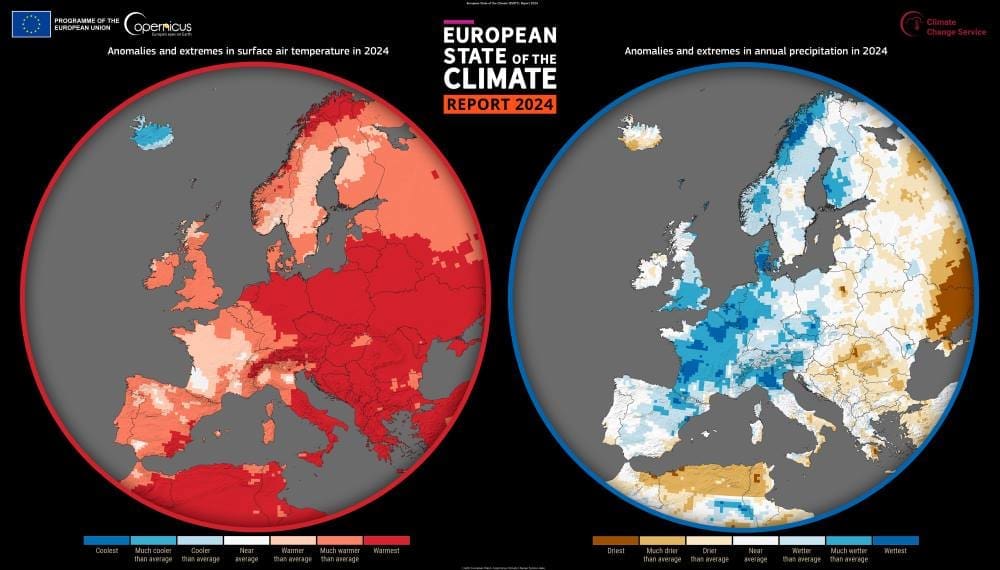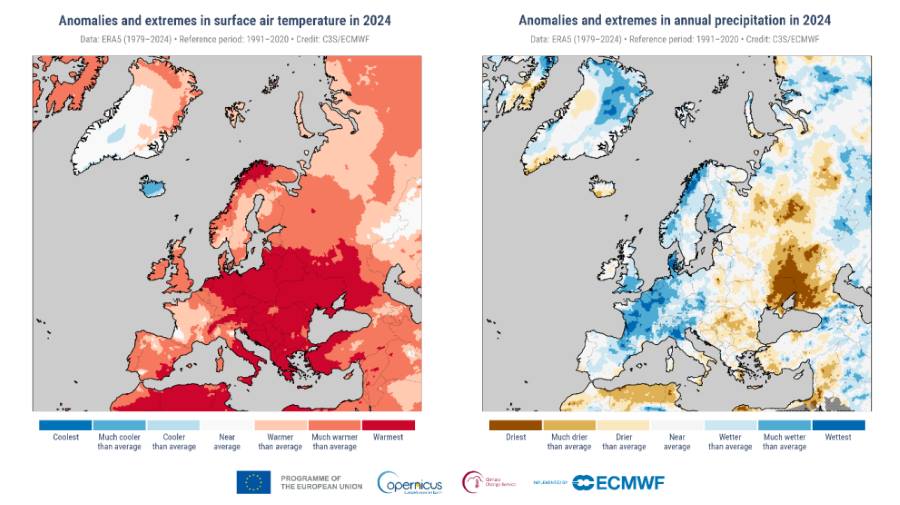A striking snapshot of Europe’s changing climate comes into focus with the release of the European State of the Climate 2024 Report, published on 15 April 2025 by the Copernicus Climate Change Service (C3S) in collaboration with the World Meteorological Organization (WMO).
According to the new report, 2024 was the warmest year on record in Europe. Nearly half the continent — approximately 48% — experienced record-breaking annual temperatures, with central, eastern, and southeastern regions particularly affected. The heat was not confined to summer alone; the entire year was marked by unusually warm conditions, affecting ecosystems, energy demand, and human health across the continent.
In addition to heat, Europe also saw widespread anomalies in precipitation patterns. The report documents a notable contrast between the west and the east: while western Europe endured persistent, wetter-than-average conditions leading to widespread flooding, many areas in eastern Europe faced the opposite — an extended period of dryness and below-average rainfall. Overall, about 34% of European land experienced higher-than-average precipitation in 2024, a figure that underscores the increasing instability of regional weather systems.

At the center of today’s image is a data visualisation built from the same Copernicus datasets used in the report. It maps out the surface air temperature anomalies and annual precipitation extremes across Europe, offering a powerful, compact representation of the continent’s shifting climate over the past year. Orange and red hues show where record-breaking warmth took hold, while shades of blue mark the areas deluged by rainfall. Drier-than-normal zones appear in yellow and brown, giving visual clarity to the pronounced east-west climate divide.
The visual not only communicates the scientific findings — it also illustrates the daily lived experience of millions across Europe in 2024. In France, Germany, and the UK, repeated flood events tested infrastructure and emergency services. Meanwhile, in parts of Ukraine, Romania, and the Balkans, dry conditions strained agricultural output and water supplies. These events, while locally distinct, are connected by broader atmospheric changes that are now more systematically tracked and understood through initiatives like C3S.

The European State of the Climate report is an annual flagship publication that draws on vast amounts of satellite and in situ data collected through the Copernicus Earth observation program. It offers both retrospective analysis and context for policymakers, researchers, and the public. This year’s edition features an extensive gallery of over 130 charts and infographics, offering detailed insights into temperature, precipitation, sea ice, greenhouse gas concentrations, and more.
Beyond numbers, the report emphasizes the growing urgency to adapt to a changing climate. While mitigation remains crucial, the persistent extremes recorded in 2024 — from scorching heatwaves to devastating floods — highlight the necessity for better preparedness, more resilient infrastructure, and improved early warning systems.
Today’s image condenses these insights into one compelling frame — a year of contrasts, anomalies, and records. As Europe continues to warm at nearly twice the global average, the data behind this image becomes more than a scientific reference. It becomes a record of lived change and a prompt for what must come next.
More information:
Copernicus Climate Change Service (C3S) and World Meteorological Organization (WMO), ‘European State of the Climate 2024’ (2025). DOI: 10.24381/14j9-s541
Article Source: Copernicus Climate Change Service (C3S)
Featured image credit: European Union, Copernicus Climate Change Service Data



